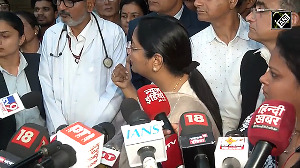The All England Club has invested in all the latest high-tech equipment and spends thousands of dollars every year researching the best grasses, soils and techniques to produce the finest tennis courts but has found the most effective and humane solution to the problem of pigeons is low-tech Hamish.
Pigeon droppings, containing high levels of ammonia, can ruin the most carefully tended lawn and Hamish is brought in three times a week to fly above the club, scaring away the other birds.
Head groundsman Eddie Seaward, who has ministered to the green swards of Wimbledon for some 13 years, has had to resort to rather more technological means to deter another lawn wrecker -- the fox.
He has had small electric fences installed round centre and number one courts just in case the families of foxes who live inside the grounds decided to use the show arenas as lavatories.
"If vixens urinated on the grass it would be destroyed. The fences don't hurt them they just teach them not to come inside," Seaward said.
Fox families live all year at the club but during Wimbledon fortnight, June 23 to July 6 this year, when the leafy London suburb is invaded by legions of tennis fans, they take refuge in the bushes around the nearby car parks, golf course and common.
Wimbledon is the only grand slam tournament still played on grass, after the U.S. and Australian Opens switched to less labour-intensive and more predictable hard courts in 1978 and 1987 respectively.
GRASS MIXTURE
Despite perennial criticism that the surface is too fast and the bounce too low, over-favouring serve-and-volley exponents, the All England Club has refused to dig up its lawns, choosing instead to look for ways of developing soil and grass mixtures to improve bounce.
With the help of the Sports Turf Research Institute in Yorkshire, where experts test different sods for wear and bounce using a machine equipped with a tennis shoe mimicking the thump, slide and scuff of 13 days' top-class competition, Seaward has discovered a combination that has changed the way the courts play.
The mixture of two rye grasses on a soil of 22 percent clay added to sands and silts has delivered a surface that allows as high a bounce as off concrete, Seaward says.
It is a delicate balance creating a lawn that can withstand punishment, that allows air to circulate over the soil so it can dry out and harden and that still looks good.
Seaward has noticed a big difference in wear over the last 10 years, proving the surface is much friendlier to baseliners than it used to be.
"The wear used to be inside the service line towards the net," he said. "Now there is much more along the baseline and much less where players go to volley," he said.
"Over the years the courts have got that bit harder so players are more comfortable standing back...they are playing rallies again which is great."
While big server Pete Sampras dominated Wimbledon during the 1990s, last year's winner Lleyton Hewitt plays from the back of the court as does runner-up David Nalbandian.
ENGLISH WEATHER
Seaward and his team test the rebound and hardness of Wimbledon's courts every day during the championships and check every centimetre for bumps or holes.
The courts receive a mighty battering, suffering wear the equivalent of 50 soccer matches during the 14 days.
But while they have an array of precise and scientific equipment to tend their precious plots the team cannot control the English weather.
Seaward recalls his greatest disaster in 1996 when the courts had to be covered for three days because of rain and the grass beneath, covered by an opaque tarpaulin, grew madly as it searched for light.
When the covers came off he found a damp, slick, bright green surface with long blades seriously weakened by overgrowth and a nightmare to play on.
The club has since invested in huge fans that dry the soil quickly and a transparent cover so the grass can bask in light even when covered.
Rain, that during spring helped the grass to grow into today's immaculate green carpet, is now Seaward's greatest enemy. He is constantly in touch with Britain's weather centre, receiving detailed short and long-term forecasts.
"Humidity, cloud level, temperature, all affect how the court plays," he said.
"What would be ideal from now on and right through the tournament would be wall-to-wall sunshine."
Players and spectators would agree with that.








 © 2025
© 2025